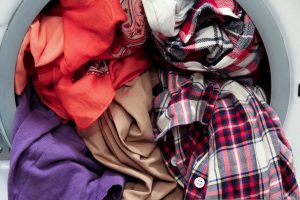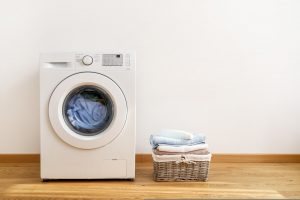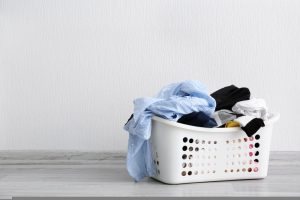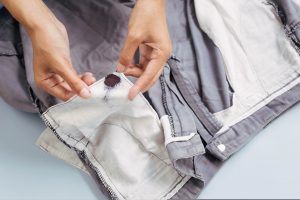We know that working out how to use a washing machine whilst living in a student home can prove to be difficult. Which is why we’ve set up this helpful step by step guide so you can wash your clothes with ease.
Say goodbye to stressing about how to do laundry or taking your washing back to your parents’ house with you, we’ve got you covered!
1. Check Your Clothes Label
Okay so the first thing to do before anything else, is ensuring that your clothes can be machined washed.
You don’t want to make the mistake of putting something in the washing machine that should only be hand washed like certain silks or delicate clothing, we’ve been there and done that, it’s not great.
Most clothing can be machine washed these days, just try to remember to check the clothing care label which should be easy to find and read the washing instructions first.
They should say which temperature to wash the clothing piece at, what particular cycle or spin programme to use and maybe even which type of detergent to use.
2. Separate Your Clothes
Before putting your clothes into the washing machine, make sure to prepare each pile and don’t just shove a load of mixed colours in together as they can bleed into each other and damage your clothes.
For example, don’t put a pink pair of socks in with your white t-shirts, otherwise you’re just going to end up with slightly pink toned t-shirts, unless of course that’s what you want.
We suggest separating your clothes by whites, lights, darks, and delicates as well as washing your towels and bedding separately.
You can even get laundry bags for your delicate items like underwear, tights or silks to stop them from getting ripped, torn, or damaged.
3. Check Your Pockets
We suggest checking all your pockets on your clothing before putting them into the machine just in case, you never know what you may have accidentally left in them whether it’s your headphones or a pack of chewies.
Or worse, a metal item could break the glass on the machine or could damage the drum (oh no). It’s better to be safe than sorry!
4. Don’t Overload The Machine
Okay, so now its onto placing your separated laundry into the machine.
We know you’ve probably got a massive pile of clothes building up in your room. However, try to ensure you’re not putting too many clothes or too many heavy clothing items inside at once.
We know it can feel like a waste having to do multiple washes, and we do want to save energy and water. However, not only will your clothes not be washed properly meaning you’ll have to wash them again, but it can also cause problems with the machine!
If you’re struggling to shut the door on the machine, chances are you’ve put too many clothes in there.

5. Choosing The Right Settings
Washing machines come with all different types of settings and cycles, and it can be confusing to know which ones to use.
Most of the time, you can just keep it simple and use a quick-wash option on your washing machine.
When choosing your settings, you should try not to wash your clothes on anything higher than 30 degrees as a lower temp wash uses less energy. Although, if you do have clothes which have stains on them or are considerably dirty then you may want to wash them on a higher temperature.
As we said earlier, its best to look at the clothing label to determine what temperature or cycle to put a clothing item on.
Here are some of the most common washing cycles:
- Cottons – Should be used to wash cotton clothes or bed sheets and towels.
- Synthetics – Best setting for synthetic fabrics, such as polyester sportswear.
- Delicates – This is the best setting for a gentle wash for clothing such as silk shirts or lace tops.
- Quick Wash – If you need your washing done asap, or don’t want to faff around then this is a good option. However, it’s not recommended for any delicate clothing items.

6. Using Fabric Softener & Detergent
After you’ve determined which cycle to put your clothes on, it’s now time to add your detergent and fabric softener to the machine. This is the part that most people struggle with, but don’t stress it is pretty straightforward.
No matter whether you’re using liquid, pods or powder laundry detergent, always make sure it is suited to the fabric you are washing and follow the instructions on the packaging. We are partial to using washing pods as they’re easier, but it’s up to you which type you use.
If you’re using liquid or powdered detergent, then you will need to use the machine drawer in the front to add these. Although, you can also put liquid detergent in the drum too depending on the brand, just be careful with the amount you’re using.
Most washing machines In the UK come with 3 compartments in the drawer, one is for detergent if you’re doing a ‘pre-wash’, the next is for the main wash’s detergent and the other is for the fabric softener/conditioner.
It’s easy to determine which is which as the fabric softener compartment should have a flower symbol on it whilst the main wash drawer should be the biggest.
Remember not to fill liquids above the ‘max’ line as it can leave your clothes smelling of soap and can risk clogging up the machine!
7. Start The Cycle
You’re all sorted! Close the door and press the start button. Most machines will indicate if the door isn’t shut properly by either a light popping up or a beep, however, some older machines might not do this.
So, double check you’ve closed the door over properly. The last thing you want to do is risk your student home flooding with water from not shutting the washing machine properly, it wouldn’t be ideal.
We like to set a timer after we’ve put our washing on a cycle, so we don’t keep coming to check when it’s finished.
8. Make Sure To Take Your Clothes Out
Try to remove your clothes from the washing machine ASAP when the cycle has finished to ensure that they can be dried whether it’s putting them in the tumble dryer (if you’re lucky to have one of these in your student home) or hanging them on the maiden to air out.
If you leave your wet clothes in the machine for too long, then they will become damp and can develop a smell due to the growth of bacteria and mold.
We’re not saying you can’t leave them for a few hours if you’re going out or studying, but just ensure you’re not forgetting about your washing overnight.
Chances are, your housemates will be waiting to use the machine too so try to remember to remove your laundry out when its finished, sounds fair, right?!
And that’s it from us, we hope we’ve managed to teach you how to do your laundry, now go and get a load on! If you’re still struggling, then watch a YouTube or TikTok tutorial to help you.
For you to read next: All the Money-Saving Tips and Fun Tricks for Your Next House Party.
Check out our cosy student houses located in prime locations across the UK.







